Mr. College - AB388H1: Contemporary Hospitality Industry Report
VerifiedAdded on 2019/12/18
|12
|4399
|600
Report
AI Summary
This report provides a detailed analysis of the contemporary hospitality industry, specifically focusing on the United Kingdom. It begins with an overview of the industry's scale, scope, and diversity, highlighting its significant contribution to the UK economy and its various sub-sectors, including hotels, restaurants, and tourism-related businesses. The report then delves into the organizational structures of different hospitality organizations, such as Premier Inn, examining their functional, divisional, and matrix structures and how they impact communication and efficiency. Furthermore, the report assesses the role of hospitality-related organizations and professional bodies like the British Hospitality Association (BHA) and People 1st. It also evaluates staffing requirements, discussing the challenges of labor shortages, the prevalence of certain demographics in the workforce, and the drawbacks associated with the job roles. The report concludes by identifying current trends affecting the industry and their potential impact on its future course.
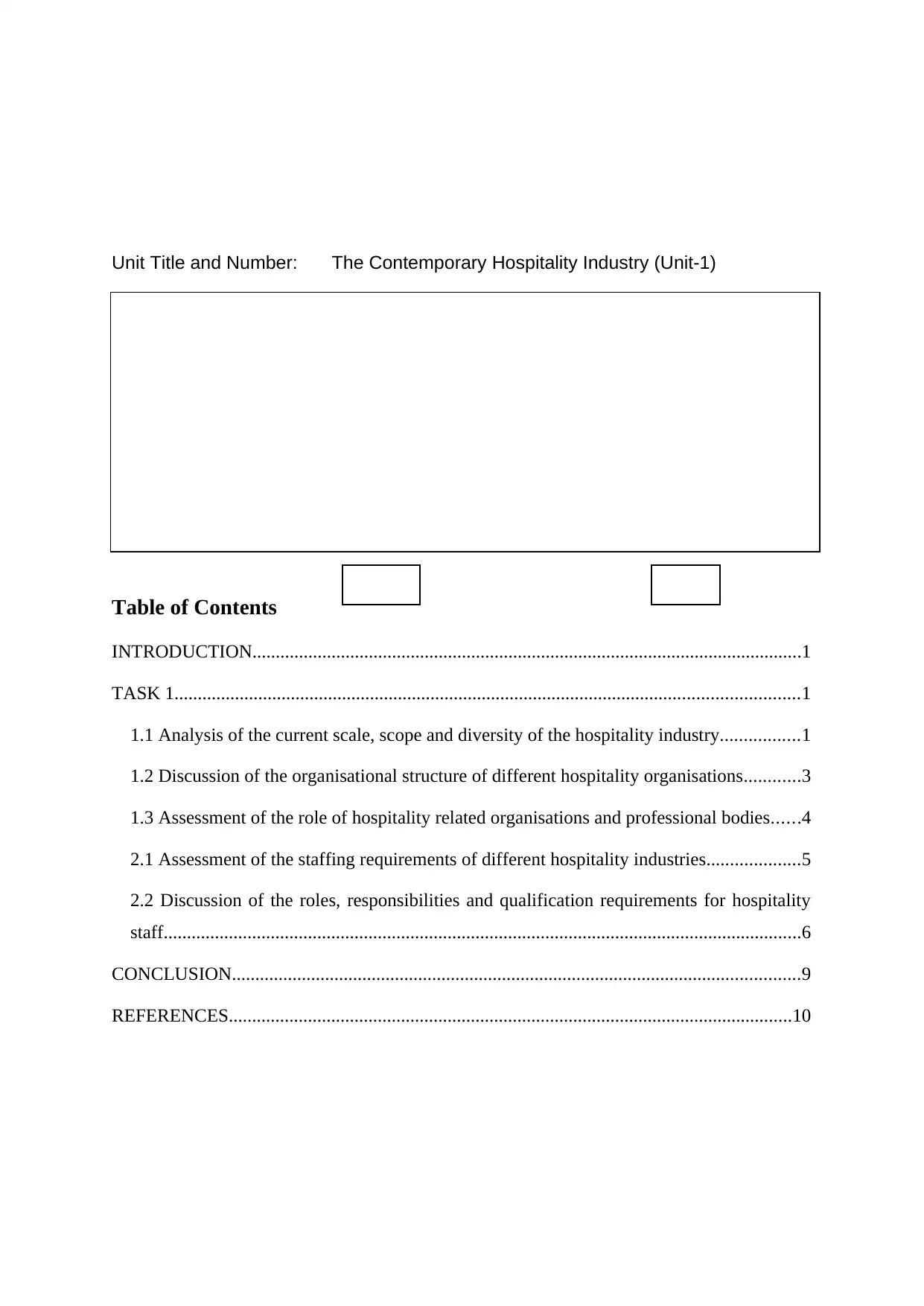
Unit Title and Number: The Contemporary Hospitality Industry (Unit-1)
Table of Contents
INTRODUCTION......................................................................................................................1
TASK 1......................................................................................................................................1
1.1 Analysis of the current scale, scope and diversity of the hospitality industry.................1
1.2 Discussion of the organisational structure of different hospitality organisations............3
1.3 Assessment of the role of hospitality related organisations and professional bodies......4
2.1 Assessment of the staffing requirements of different hospitality industries....................5
2.2 Discussion of the roles, responsibilities and qualification requirements for hospitality
staff.........................................................................................................................................6
CONCLUSION..........................................................................................................................9
REFERENCES.........................................................................................................................10
Table of Contents
INTRODUCTION......................................................................................................................1
TASK 1......................................................................................................................................1
1.1 Analysis of the current scale, scope and diversity of the hospitality industry.................1
1.2 Discussion of the organisational structure of different hospitality organisations............3
1.3 Assessment of the role of hospitality related organisations and professional bodies......4
2.1 Assessment of the staffing requirements of different hospitality industries....................5
2.2 Discussion of the roles, responsibilities and qualification requirements for hospitality
staff.........................................................................................................................................6
CONCLUSION..........................................................................................................................9
REFERENCES.........................................................................................................................10
Paraphrase This Document
Need a fresh take? Get an instant paraphrase of this document with our AI Paraphraser
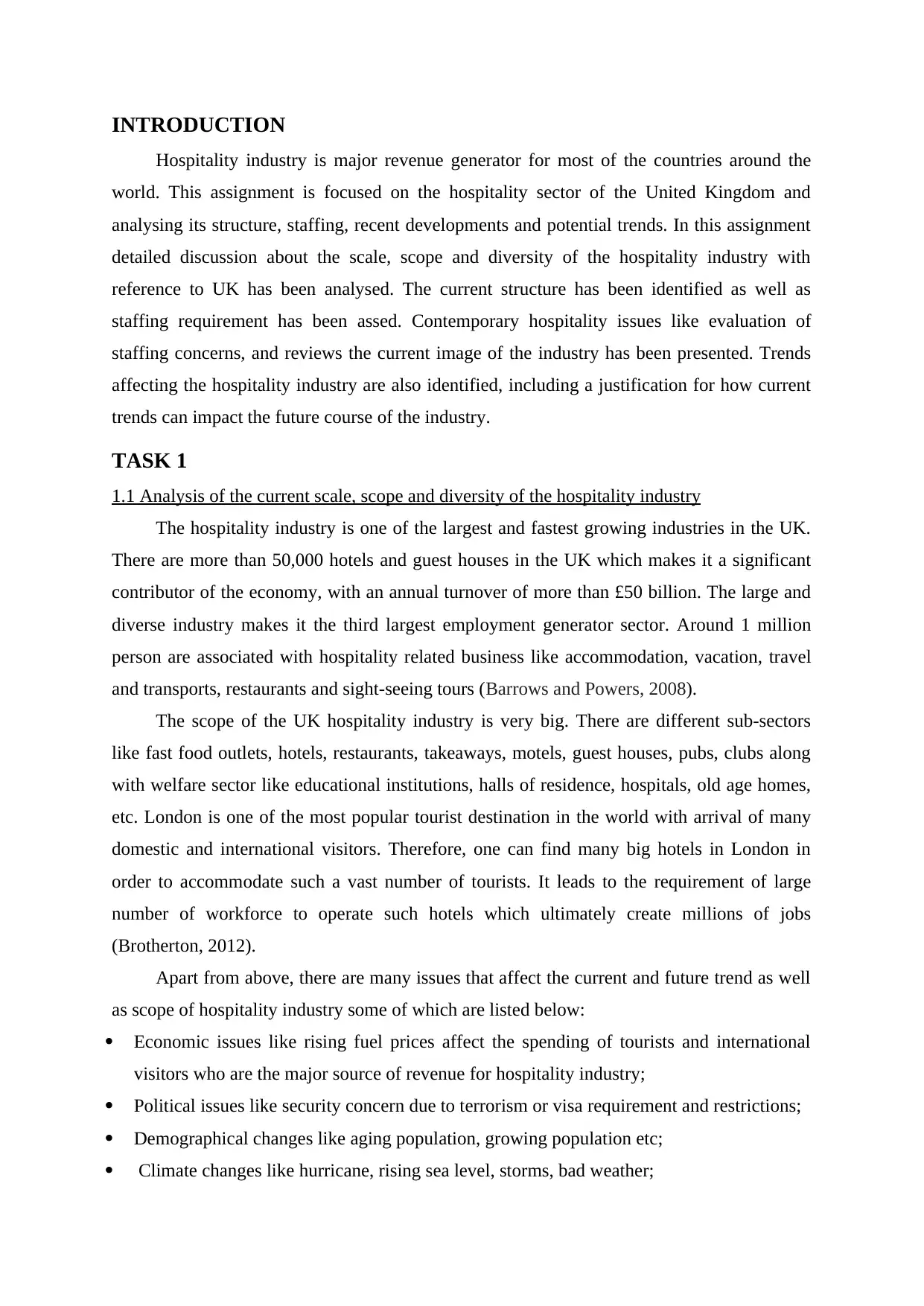
INTRODUCTION
Hospitality industry is major revenue generator for most of the countries around the
world. This assignment is focused on the hospitality sector of the United Kingdom and
analysing its structure, staffing, recent developments and potential trends. In this assignment
detailed discussion about the scale, scope and diversity of the hospitality industry with
reference to UK has been analysed. The current structure has been identified as well as
staffing requirement has been assed. Contemporary hospitality issues like evaluation of
staffing concerns, and reviews the current image of the industry has been presented. Trends
affecting the hospitality industry are also identified, including a justification for how current
trends can impact the future course of the industry.
TASK 1
1.1 Analysis of the current scale, scope and diversity of the hospitality industry
The hospitality industry is one of the largest and fastest growing industries in the UK.
There are more than 50,000 hotels and guest houses in the UK which makes it a significant
contributor of the economy, with an annual turnover of more than £50 billion. The large and
diverse industry makes it the third largest employment generator sector. Around 1 million
person are associated with hospitality related business like accommodation, vacation, travel
and transports, restaurants and sight-seeing tours (Barrows and Powers, 2008).
The scope of the UK hospitality industry is very big. There are different sub-sectors
like fast food outlets, hotels, restaurants, takeaways, motels, guest houses, pubs, clubs along
with welfare sector like educational institutions, halls of residence, hospitals, old age homes,
etc. London is one of the most popular tourist destination in the world with arrival of many
domestic and international visitors. Therefore, one can find many big hotels in London in
order to accommodate such a vast number of tourists. It leads to the requirement of large
number of workforce to operate such hotels which ultimately create millions of jobs
(Brotherton, 2012).
Apart from above, there are many issues that affect the current and future trend as well
as scope of hospitality industry some of which are listed below:
Economic issues like rising fuel prices affect the spending of tourists and international
visitors who are the major source of revenue for hospitality industry;
Political issues like security concern due to terrorism or visa requirement and restrictions;
Demographical changes like aging population, growing population etc;
Climate changes like hurricane, rising sea level, storms, bad weather;
Hospitality industry is major revenue generator for most of the countries around the
world. This assignment is focused on the hospitality sector of the United Kingdom and
analysing its structure, staffing, recent developments and potential trends. In this assignment
detailed discussion about the scale, scope and diversity of the hospitality industry with
reference to UK has been analysed. The current structure has been identified as well as
staffing requirement has been assed. Contemporary hospitality issues like evaluation of
staffing concerns, and reviews the current image of the industry has been presented. Trends
affecting the hospitality industry are also identified, including a justification for how current
trends can impact the future course of the industry.
TASK 1
1.1 Analysis of the current scale, scope and diversity of the hospitality industry
The hospitality industry is one of the largest and fastest growing industries in the UK.
There are more than 50,000 hotels and guest houses in the UK which makes it a significant
contributor of the economy, with an annual turnover of more than £50 billion. The large and
diverse industry makes it the third largest employment generator sector. Around 1 million
person are associated with hospitality related business like accommodation, vacation, travel
and transports, restaurants and sight-seeing tours (Barrows and Powers, 2008).
The scope of the UK hospitality industry is very big. There are different sub-sectors
like fast food outlets, hotels, restaurants, takeaways, motels, guest houses, pubs, clubs along
with welfare sector like educational institutions, halls of residence, hospitals, old age homes,
etc. London is one of the most popular tourist destination in the world with arrival of many
domestic and international visitors. Therefore, one can find many big hotels in London in
order to accommodate such a vast number of tourists. It leads to the requirement of large
number of workforce to operate such hotels which ultimately create millions of jobs
(Brotherton, 2012).
Apart from above, there are many issues that affect the current and future trend as well
as scope of hospitality industry some of which are listed below:
Economic issues like rising fuel prices affect the spending of tourists and international
visitors who are the major source of revenue for hospitality industry;
Political issues like security concern due to terrorism or visa requirement and restrictions;
Demographical changes like aging population, growing population etc;
Climate changes like hurricane, rising sea level, storms, bad weather;
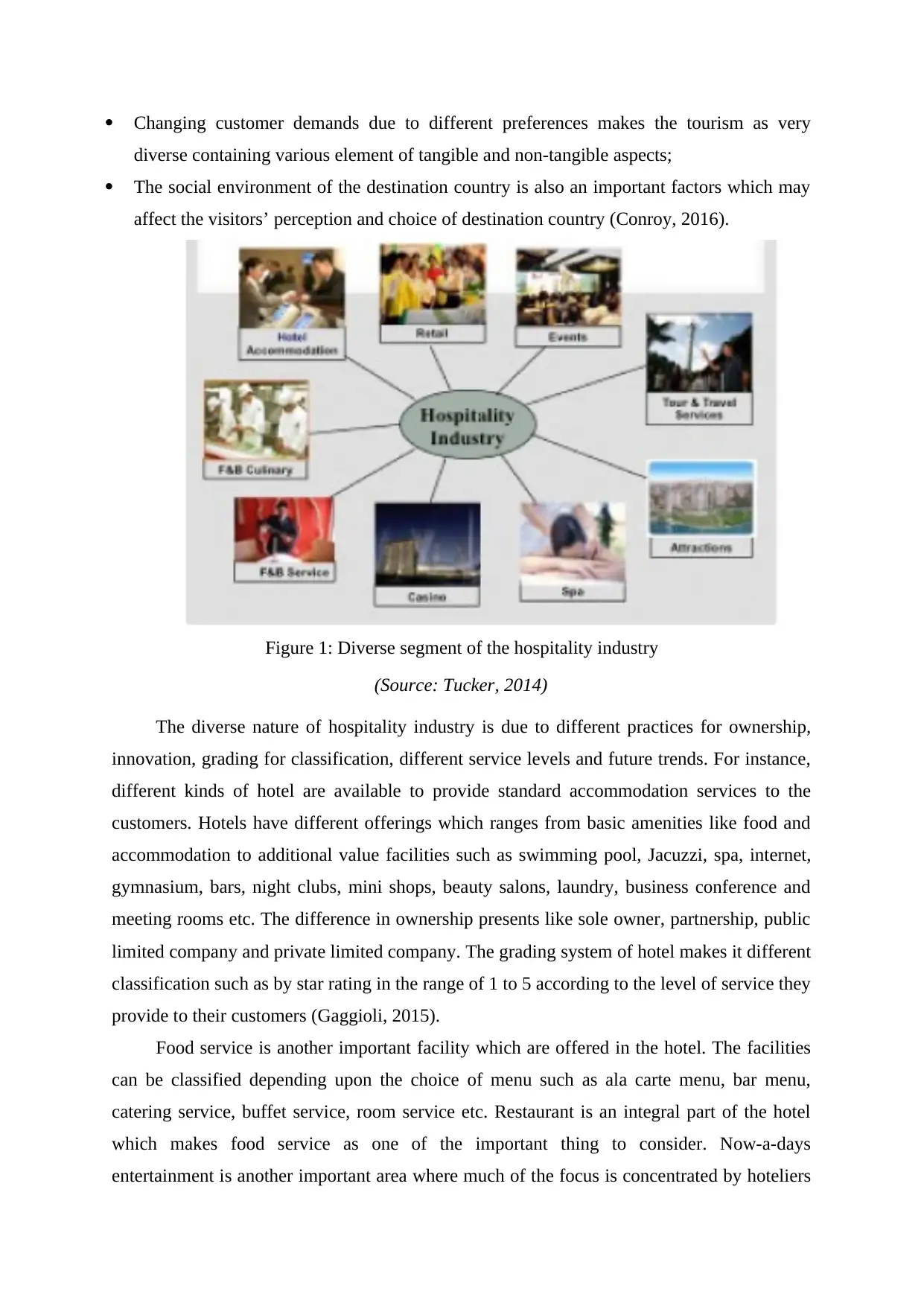
Changing customer demands due to different preferences makes the tourism as very
diverse containing various element of tangible and non-tangible aspects;
The social environment of the destination country is also an important factors which may
affect the visitors’ perception and choice of destination country (Conroy, 2016).
Figure 1: Diverse segment of the hospitality industry
(Source: Tucker, 2014)
The diverse nature of hospitality industry is due to different practices for ownership,
innovation, grading for classification, different service levels and future trends. For instance,
different kinds of hotel are available to provide standard accommodation services to the
customers. Hotels have different offerings which ranges from basic amenities like food and
accommodation to additional value facilities such as swimming pool, Jacuzzi, spa, internet,
gymnasium, bars, night clubs, mini shops, beauty salons, laundry, business conference and
meeting rooms etc. The difference in ownership presents like sole owner, partnership, public
limited company and private limited company. The grading system of hotel makes it different
classification such as by star rating in the range of 1 to 5 according to the level of service they
provide to their customers (Gaggioli, 2015).
Food service is another important facility which are offered in the hotel. The facilities
can be classified depending upon the choice of menu such as ala carte menu, bar menu,
catering service, buffet service, room service etc. Restaurant is an integral part of the hotel
which makes food service as one of the important thing to consider. Now-a-days
entertainment is another important area where much of the focus is concentrated by hoteliers
diverse containing various element of tangible and non-tangible aspects;
The social environment of the destination country is also an important factors which may
affect the visitors’ perception and choice of destination country (Conroy, 2016).
Figure 1: Diverse segment of the hospitality industry
(Source: Tucker, 2014)
The diverse nature of hospitality industry is due to different practices for ownership,
innovation, grading for classification, different service levels and future trends. For instance,
different kinds of hotel are available to provide standard accommodation services to the
customers. Hotels have different offerings which ranges from basic amenities like food and
accommodation to additional value facilities such as swimming pool, Jacuzzi, spa, internet,
gymnasium, bars, night clubs, mini shops, beauty salons, laundry, business conference and
meeting rooms etc. The difference in ownership presents like sole owner, partnership, public
limited company and private limited company. The grading system of hotel makes it different
classification such as by star rating in the range of 1 to 5 according to the level of service they
provide to their customers (Gaggioli, 2015).
Food service is another important facility which are offered in the hotel. The facilities
can be classified depending upon the choice of menu such as ala carte menu, bar menu,
catering service, buffet service, room service etc. Restaurant is an integral part of the hotel
which makes food service as one of the important thing to consider. Now-a-days
entertainment is another important area where much of the focus is concentrated by hoteliers
⊘ This is a preview!⊘
Do you want full access?
Subscribe today to unlock all pages.

Trusted by 1+ million students worldwide
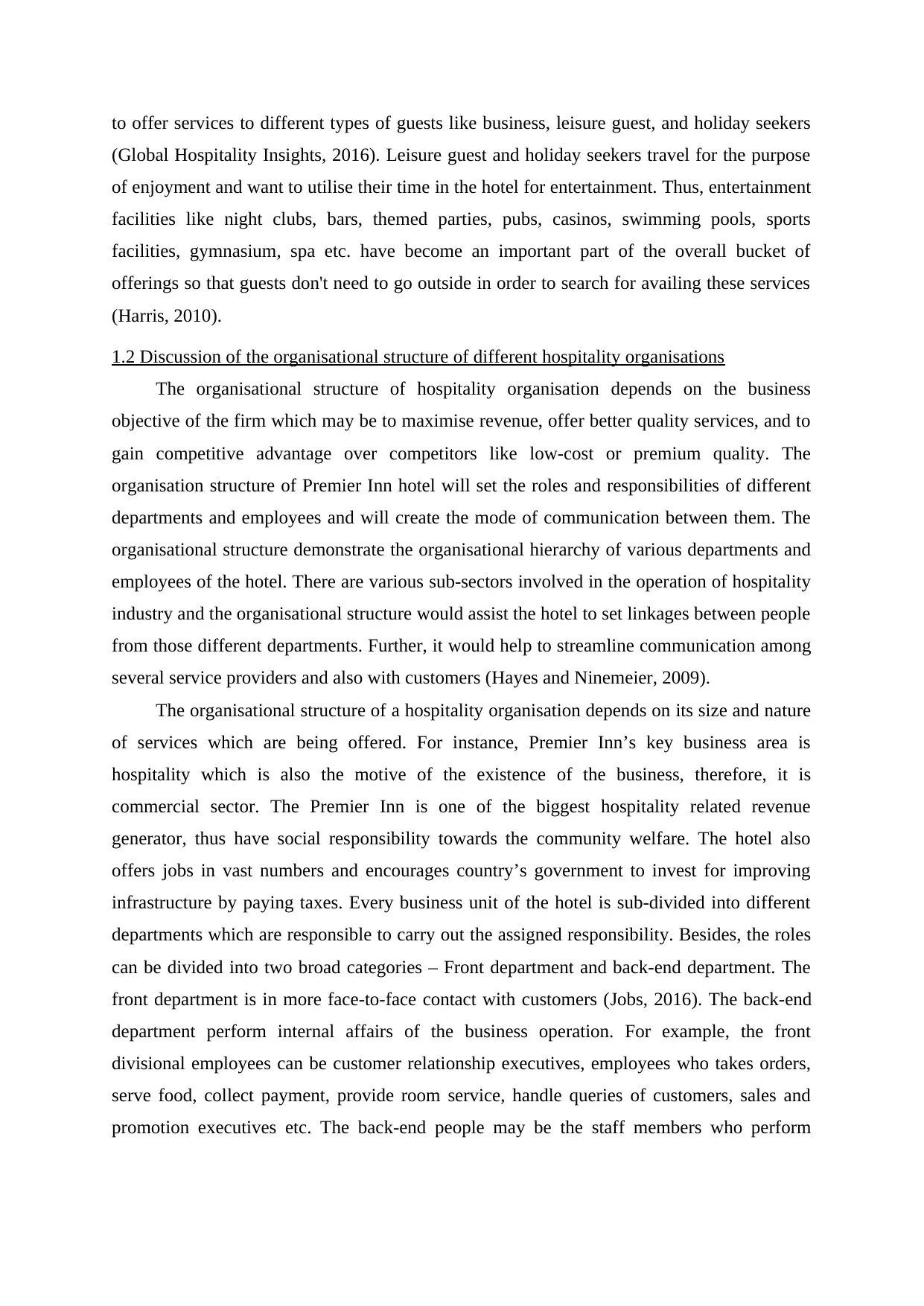
to offer services to different types of guests like business, leisure guest, and holiday seekers
(Global Hospitality Insights, 2016). Leisure guest and holiday seekers travel for the purpose
of enjoyment and want to utilise their time in the hotel for entertainment. Thus, entertainment
facilities like night clubs, bars, themed parties, pubs, casinos, swimming pools, sports
facilities, gymnasium, spa etc. have become an important part of the overall bucket of
offerings so that guests don't need to go outside in order to search for availing these services
(Harris, 2010).
1.2 Discussion of the organisational structure of different hospitality organisations
The organisational structure of hospitality organisation depends on the business
objective of the firm which may be to maximise revenue, offer better quality services, and to
gain competitive advantage over competitors like low-cost or premium quality. The
organisation structure of Premier Inn hotel will set the roles and responsibilities of different
departments and employees and will create the mode of communication between them. The
organisational structure demonstrate the organisational hierarchy of various departments and
employees of the hotel. There are various sub-sectors involved in the operation of hospitality
industry and the organisational structure would assist the hotel to set linkages between people
from those different departments. Further, it would help to streamline communication among
several service providers and also with customers (Hayes and Ninemeier, 2009).
The organisational structure of a hospitality organisation depends on its size and nature
of services which are being offered. For instance, Premier Inn’s key business area is
hospitality which is also the motive of the existence of the business, therefore, it is
commercial sector. The Premier Inn is one of the biggest hospitality related revenue
generator, thus have social responsibility towards the community welfare. The hotel also
offers jobs in vast numbers and encourages country’s government to invest for improving
infrastructure by paying taxes. Every business unit of the hotel is sub-divided into different
departments which are responsible to carry out the assigned responsibility. Besides, the roles
can be divided into two broad categories – Front department and back-end department. The
front department is in more face-to-face contact with customers (Jobs, 2016). The back-end
department perform internal affairs of the business operation. For example, the front
divisional employees can be customer relationship executives, employees who takes orders,
serve food, collect payment, provide room service, handle queries of customers, sales and
promotion executives etc. The back-end people may be the staff members who perform
(Global Hospitality Insights, 2016). Leisure guest and holiday seekers travel for the purpose
of enjoyment and want to utilise their time in the hotel for entertainment. Thus, entertainment
facilities like night clubs, bars, themed parties, pubs, casinos, swimming pools, sports
facilities, gymnasium, spa etc. have become an important part of the overall bucket of
offerings so that guests don't need to go outside in order to search for availing these services
(Harris, 2010).
1.2 Discussion of the organisational structure of different hospitality organisations
The organisational structure of hospitality organisation depends on the business
objective of the firm which may be to maximise revenue, offer better quality services, and to
gain competitive advantage over competitors like low-cost or premium quality. The
organisation structure of Premier Inn hotel will set the roles and responsibilities of different
departments and employees and will create the mode of communication between them. The
organisational structure demonstrate the organisational hierarchy of various departments and
employees of the hotel. There are various sub-sectors involved in the operation of hospitality
industry and the organisational structure would assist the hotel to set linkages between people
from those different departments. Further, it would help to streamline communication among
several service providers and also with customers (Hayes and Ninemeier, 2009).
The organisational structure of a hospitality organisation depends on its size and nature
of services which are being offered. For instance, Premier Inn’s key business area is
hospitality which is also the motive of the existence of the business, therefore, it is
commercial sector. The Premier Inn is one of the biggest hospitality related revenue
generator, thus have social responsibility towards the community welfare. The hotel also
offers jobs in vast numbers and encourages country’s government to invest for improving
infrastructure by paying taxes. Every business unit of the hotel is sub-divided into different
departments which are responsible to carry out the assigned responsibility. Besides, the roles
can be divided into two broad categories – Front department and back-end department. The
front department is in more face-to-face contact with customers (Jobs, 2016). The back-end
department perform internal affairs of the business operation. For example, the front
divisional employees can be customer relationship executives, employees who takes orders,
serve food, collect payment, provide room service, handle queries of customers, sales and
promotion executives etc. The back-end people may be the staff members who perform
Paraphrase This Document
Need a fresh take? Get an instant paraphrase of this document with our AI Paraphraser
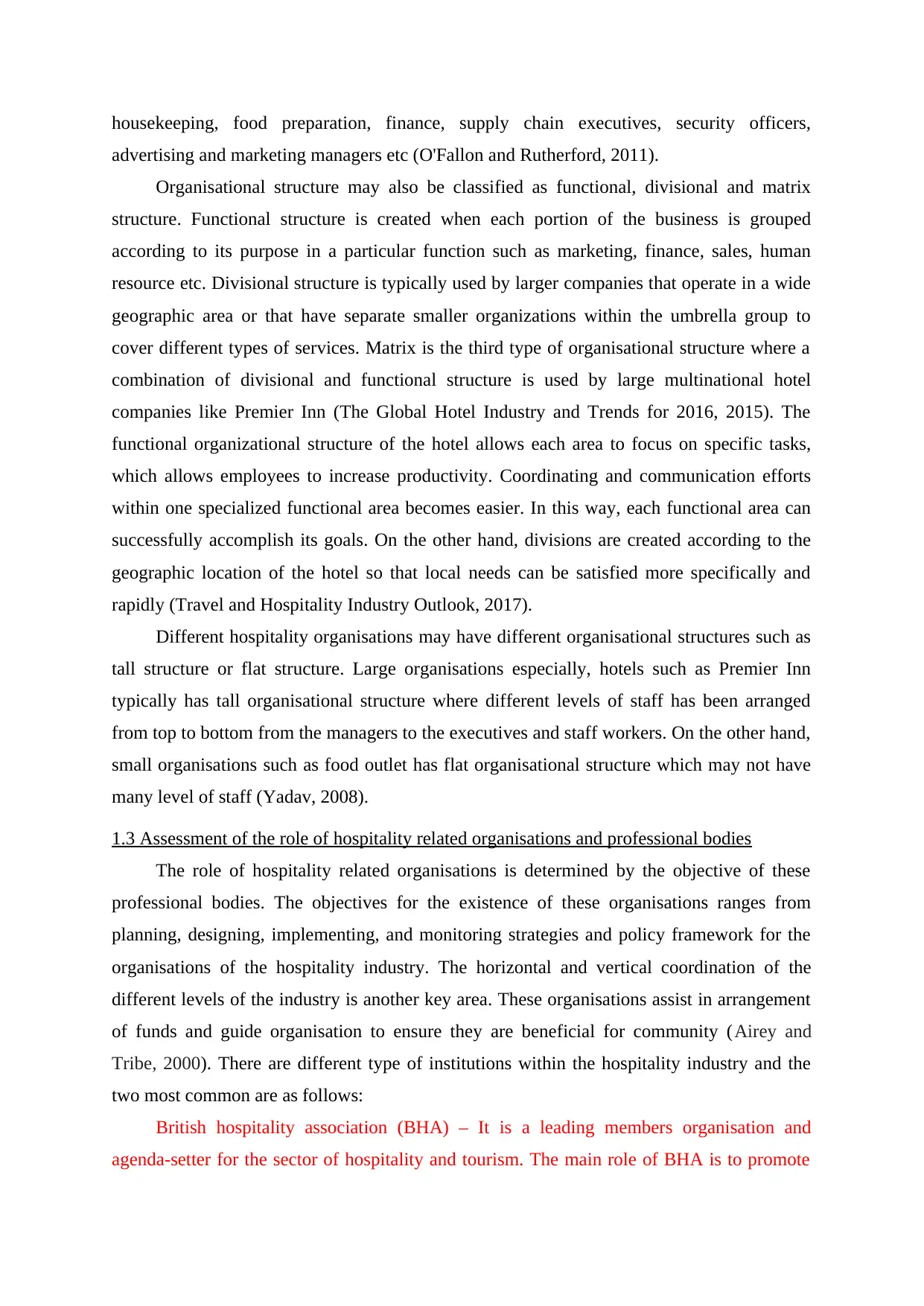
housekeeping, food preparation, finance, supply chain executives, security officers,
advertising and marketing managers etc (O'Fallon and Rutherford, 2011).
Organisational structure may also be classified as functional, divisional and matrix
structure. Functional structure is created when each portion of the business is grouped
according to its purpose in a particular function such as marketing, finance, sales, human
resource etc. Divisional structure is typically used by larger companies that operate in a wide
geographic area or that have separate smaller organizations within the umbrella group to
cover different types of services. Matrix is the third type of organisational structure where a
combination of divisional and functional structure is used by large multinational hotel
companies like Premier Inn (The Global Hotel Industry and Trends for 2016, 2015). The
functional organizational structure of the hotel allows each area to focus on specific tasks,
which allows employees to increase productivity. Coordinating and communication efforts
within one specialized functional area becomes easier. In this way, each functional area can
successfully accomplish its goals. On the other hand, divisions are created according to the
geographic location of the hotel so that local needs can be satisfied more specifically and
rapidly (Travel and Hospitality Industry Outlook, 2017).
Different hospitality organisations may have different organisational structures such as
tall structure or flat structure. Large organisations especially, hotels such as Premier Inn
typically has tall organisational structure where different levels of staff has been arranged
from top to bottom from the managers to the executives and staff workers. On the other hand,
small organisations such as food outlet has flat organisational structure which may not have
many level of staff (Yadav, 2008).
1.3 Assessment of the role of hospitality related organisations and professional bodies
The role of hospitality related organisations is determined by the objective of these
professional bodies. The objectives for the existence of these organisations ranges from
planning, designing, implementing, and monitoring strategies and policy framework for the
organisations of the hospitality industry. The horizontal and vertical coordination of the
different levels of the industry is another key area. These organisations assist in arrangement
of funds and guide organisation to ensure they are beneficial for community (Airey and
Tribe, 2000). There are different type of institutions within the hospitality industry and the
two most common are as follows:
British hospitality association (BHA) – It is a leading members organisation and
agenda-setter for the sector of hospitality and tourism. The main role of BHA is to promote
advertising and marketing managers etc (O'Fallon and Rutherford, 2011).
Organisational structure may also be classified as functional, divisional and matrix
structure. Functional structure is created when each portion of the business is grouped
according to its purpose in a particular function such as marketing, finance, sales, human
resource etc. Divisional structure is typically used by larger companies that operate in a wide
geographic area or that have separate smaller organizations within the umbrella group to
cover different types of services. Matrix is the third type of organisational structure where a
combination of divisional and functional structure is used by large multinational hotel
companies like Premier Inn (The Global Hotel Industry and Trends for 2016, 2015). The
functional organizational structure of the hotel allows each area to focus on specific tasks,
which allows employees to increase productivity. Coordinating and communication efforts
within one specialized functional area becomes easier. In this way, each functional area can
successfully accomplish its goals. On the other hand, divisions are created according to the
geographic location of the hotel so that local needs can be satisfied more specifically and
rapidly (Travel and Hospitality Industry Outlook, 2017).
Different hospitality organisations may have different organisational structures such as
tall structure or flat structure. Large organisations especially, hotels such as Premier Inn
typically has tall organisational structure where different levels of staff has been arranged
from top to bottom from the managers to the executives and staff workers. On the other hand,
small organisations such as food outlet has flat organisational structure which may not have
many level of staff (Yadav, 2008).
1.3 Assessment of the role of hospitality related organisations and professional bodies
The role of hospitality related organisations is determined by the objective of these
professional bodies. The objectives for the existence of these organisations ranges from
planning, designing, implementing, and monitoring strategies and policy framework for the
organisations of the hospitality industry. The horizontal and vertical coordination of the
different levels of the industry is another key area. These organisations assist in arrangement
of funds and guide organisation to ensure they are beneficial for community (Airey and
Tribe, 2000). There are different type of institutions within the hospitality industry and the
two most common are as follows:
British hospitality association (BHA) – It is a leading members organisation and
agenda-setter for the sector of hospitality and tourism. The main role of BHA is to promote
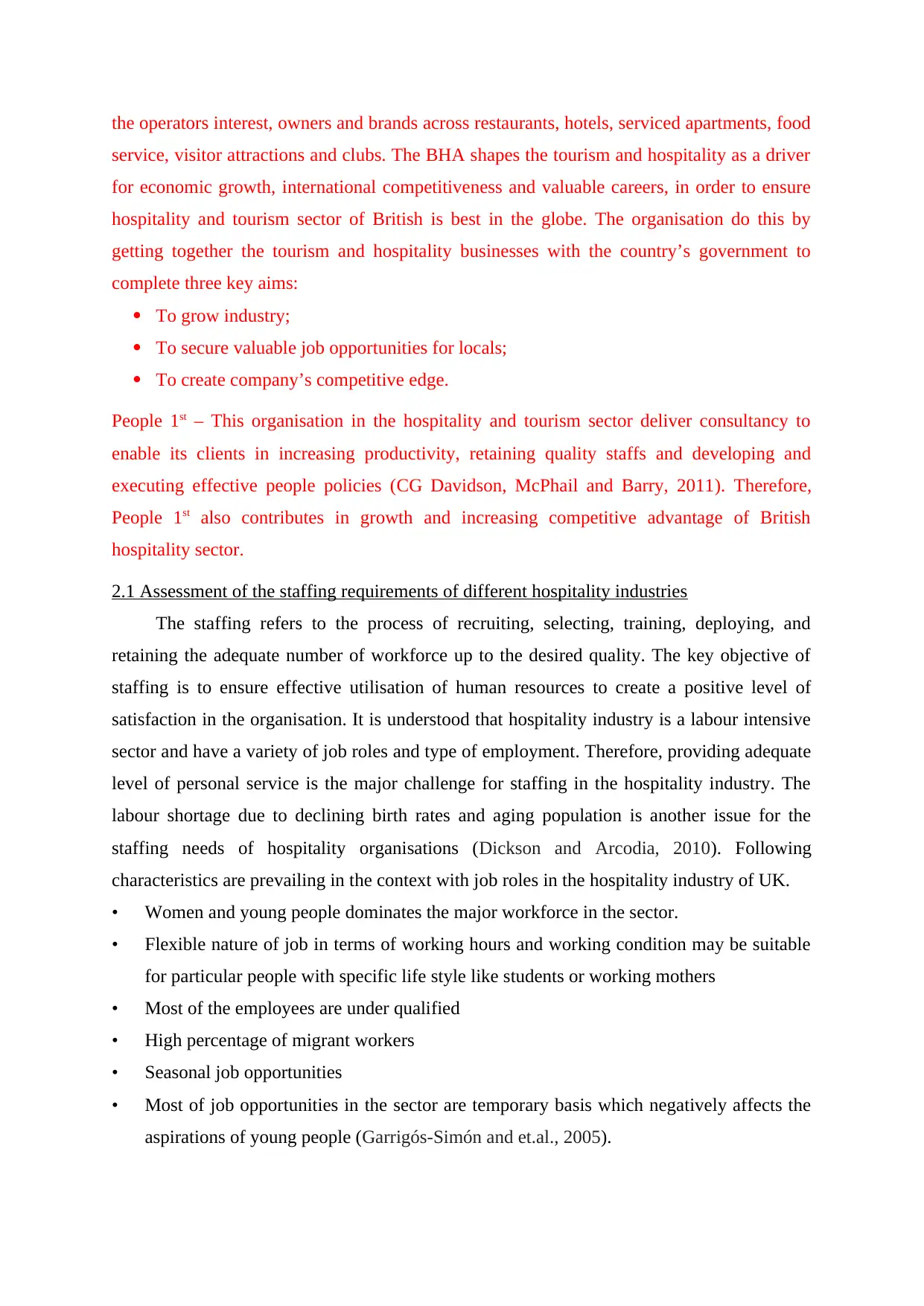
the operators interest, owners and brands across restaurants, hotels, serviced apartments, food
service, visitor attractions and clubs. The BHA shapes the tourism and hospitality as a driver
for economic growth, international competitiveness and valuable careers, in order to ensure
hospitality and tourism sector of British is best in the globe. The organisation do this by
getting together the tourism and hospitality businesses with the country’s government to
complete three key aims:
To grow industry;
To secure valuable job opportunities for locals;
To create company’s competitive edge.
People 1st – This organisation in the hospitality and tourism sector deliver consultancy to
enable its clients in increasing productivity, retaining quality staffs and developing and
executing effective people policies (CG Davidson, McPhail and Barry, 2011). Therefore,
People 1st also contributes in growth and increasing competitive advantage of British
hospitality sector.
2.1 Assessment of the staffing requirements of different hospitality industries
The staffing refers to the process of recruiting, selecting, training, deploying, and
retaining the adequate number of workforce up to the desired quality. The key objective of
staffing is to ensure effective utilisation of human resources to create a positive level of
satisfaction in the organisation. It is understood that hospitality industry is a labour intensive
sector and have a variety of job roles and type of employment. Therefore, providing adequate
level of personal service is the major challenge for staffing in the hospitality industry. The
labour shortage due to declining birth rates and aging population is another issue for the
staffing needs of hospitality organisations (Dickson and Arcodia, 2010). Following
characteristics are prevailing in the context with job roles in the hospitality industry of UK.
• Women and young people dominates the major workforce in the sector.
• Flexible nature of job in terms of working hours and working condition may be suitable
for particular people with specific life style like students or working mothers
• Most of the employees are under qualified
• High percentage of migrant workers
• Seasonal job opportunities
• Most of job opportunities in the sector are temporary basis which negatively affects the
aspirations of young people (Garrigós-Simón and et.al., 2005).
service, visitor attractions and clubs. The BHA shapes the tourism and hospitality as a driver
for economic growth, international competitiveness and valuable careers, in order to ensure
hospitality and tourism sector of British is best in the globe. The organisation do this by
getting together the tourism and hospitality businesses with the country’s government to
complete three key aims:
To grow industry;
To secure valuable job opportunities for locals;
To create company’s competitive edge.
People 1st – This organisation in the hospitality and tourism sector deliver consultancy to
enable its clients in increasing productivity, retaining quality staffs and developing and
executing effective people policies (CG Davidson, McPhail and Barry, 2011). Therefore,
People 1st also contributes in growth and increasing competitive advantage of British
hospitality sector.
2.1 Assessment of the staffing requirements of different hospitality industries
The staffing refers to the process of recruiting, selecting, training, deploying, and
retaining the adequate number of workforce up to the desired quality. The key objective of
staffing is to ensure effective utilisation of human resources to create a positive level of
satisfaction in the organisation. It is understood that hospitality industry is a labour intensive
sector and have a variety of job roles and type of employment. Therefore, providing adequate
level of personal service is the major challenge for staffing in the hospitality industry. The
labour shortage due to declining birth rates and aging population is another issue for the
staffing needs of hospitality organisations (Dickson and Arcodia, 2010). Following
characteristics are prevailing in the context with job roles in the hospitality industry of UK.
• Women and young people dominates the major workforce in the sector.
• Flexible nature of job in terms of working hours and working condition may be suitable
for particular people with specific life style like students or working mothers
• Most of the employees are under qualified
• High percentage of migrant workers
• Seasonal job opportunities
• Most of job opportunities in the sector are temporary basis which negatively affects the
aspirations of young people (Garrigós-Simón and et.al., 2005).
⊘ This is a preview!⊘
Do you want full access?
Subscribe today to unlock all pages.

Trusted by 1+ million students worldwide
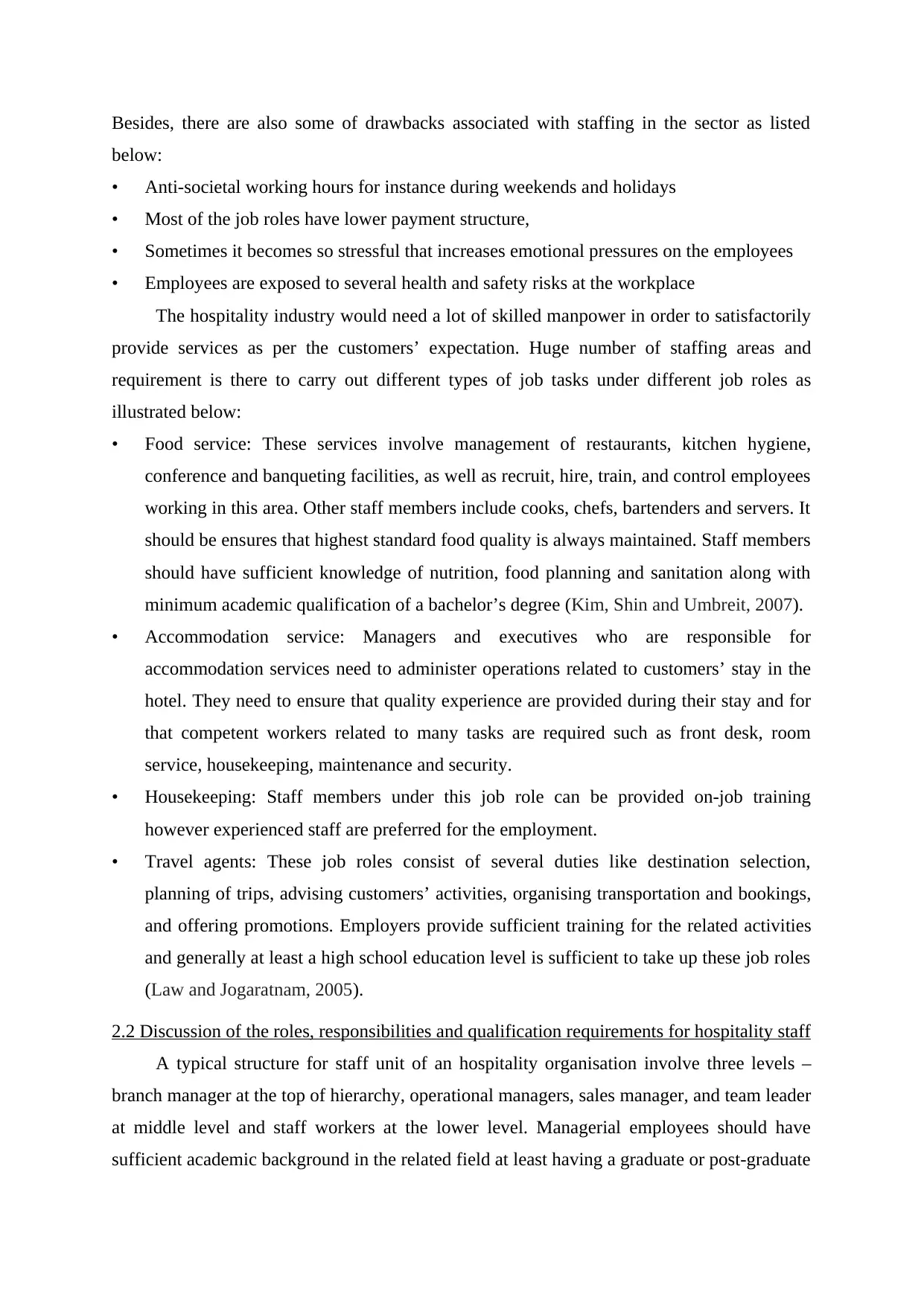
Besides, there are also some of drawbacks associated with staffing in the sector as listed
below:
• Anti-societal working hours for instance during weekends and holidays
• Most of the job roles have lower payment structure,
• Sometimes it becomes so stressful that increases emotional pressures on the employees
• Employees are exposed to several health and safety risks at the workplace
The hospitality industry would need a lot of skilled manpower in order to satisfactorily
provide services as per the customers’ expectation. Huge number of staffing areas and
requirement is there to carry out different types of job tasks under different job roles as
illustrated below:
• Food service: These services involve management of restaurants, kitchen hygiene,
conference and banqueting facilities, as well as recruit, hire, train, and control employees
working in this area. Other staff members include cooks, chefs, bartenders and servers. It
should be ensures that highest standard food quality is always maintained. Staff members
should have sufficient knowledge of nutrition, food planning and sanitation along with
minimum academic qualification of a bachelor’s degree (Kim, Shin and Umbreit, 2007).
• Accommodation service: Managers and executives who are responsible for
accommodation services need to administer operations related to customers’ stay in the
hotel. They need to ensure that quality experience are provided during their stay and for
that competent workers related to many tasks are required such as front desk, room
service, housekeeping, maintenance and security.
• Housekeeping: Staff members under this job role can be provided on-job training
however experienced staff are preferred for the employment.
• Travel agents: These job roles consist of several duties like destination selection,
planning of trips, advising customers’ activities, organising transportation and bookings,
and offering promotions. Employers provide sufficient training for the related activities
and generally at least a high school education level is sufficient to take up these job roles
(Law and Jogaratnam, 2005).
2.2 Discussion of the roles, responsibilities and qualification requirements for hospitality staff
A typical structure for staff unit of an hospitality organisation involve three levels –
branch manager at the top of hierarchy, operational managers, sales manager, and team leader
at middle level and staff workers at the lower level. Managerial employees should have
sufficient academic background in the related field at least having a graduate or post-graduate
below:
• Anti-societal working hours for instance during weekends and holidays
• Most of the job roles have lower payment structure,
• Sometimes it becomes so stressful that increases emotional pressures on the employees
• Employees are exposed to several health and safety risks at the workplace
The hospitality industry would need a lot of skilled manpower in order to satisfactorily
provide services as per the customers’ expectation. Huge number of staffing areas and
requirement is there to carry out different types of job tasks under different job roles as
illustrated below:
• Food service: These services involve management of restaurants, kitchen hygiene,
conference and banqueting facilities, as well as recruit, hire, train, and control employees
working in this area. Other staff members include cooks, chefs, bartenders and servers. It
should be ensures that highest standard food quality is always maintained. Staff members
should have sufficient knowledge of nutrition, food planning and sanitation along with
minimum academic qualification of a bachelor’s degree (Kim, Shin and Umbreit, 2007).
• Accommodation service: Managers and executives who are responsible for
accommodation services need to administer operations related to customers’ stay in the
hotel. They need to ensure that quality experience are provided during their stay and for
that competent workers related to many tasks are required such as front desk, room
service, housekeeping, maintenance and security.
• Housekeeping: Staff members under this job role can be provided on-job training
however experienced staff are preferred for the employment.
• Travel agents: These job roles consist of several duties like destination selection,
planning of trips, advising customers’ activities, organising transportation and bookings,
and offering promotions. Employers provide sufficient training for the related activities
and generally at least a high school education level is sufficient to take up these job roles
(Law and Jogaratnam, 2005).
2.2 Discussion of the roles, responsibilities and qualification requirements for hospitality staff
A typical structure for staff unit of an hospitality organisation involve three levels –
branch manager at the top of hierarchy, operational managers, sales manager, and team leader
at middle level and staff workers at the lower level. Managerial employees should have
sufficient academic background in the related field at least having a graduate or post-graduate
Paraphrase This Document
Need a fresh take? Get an instant paraphrase of this document with our AI Paraphraser
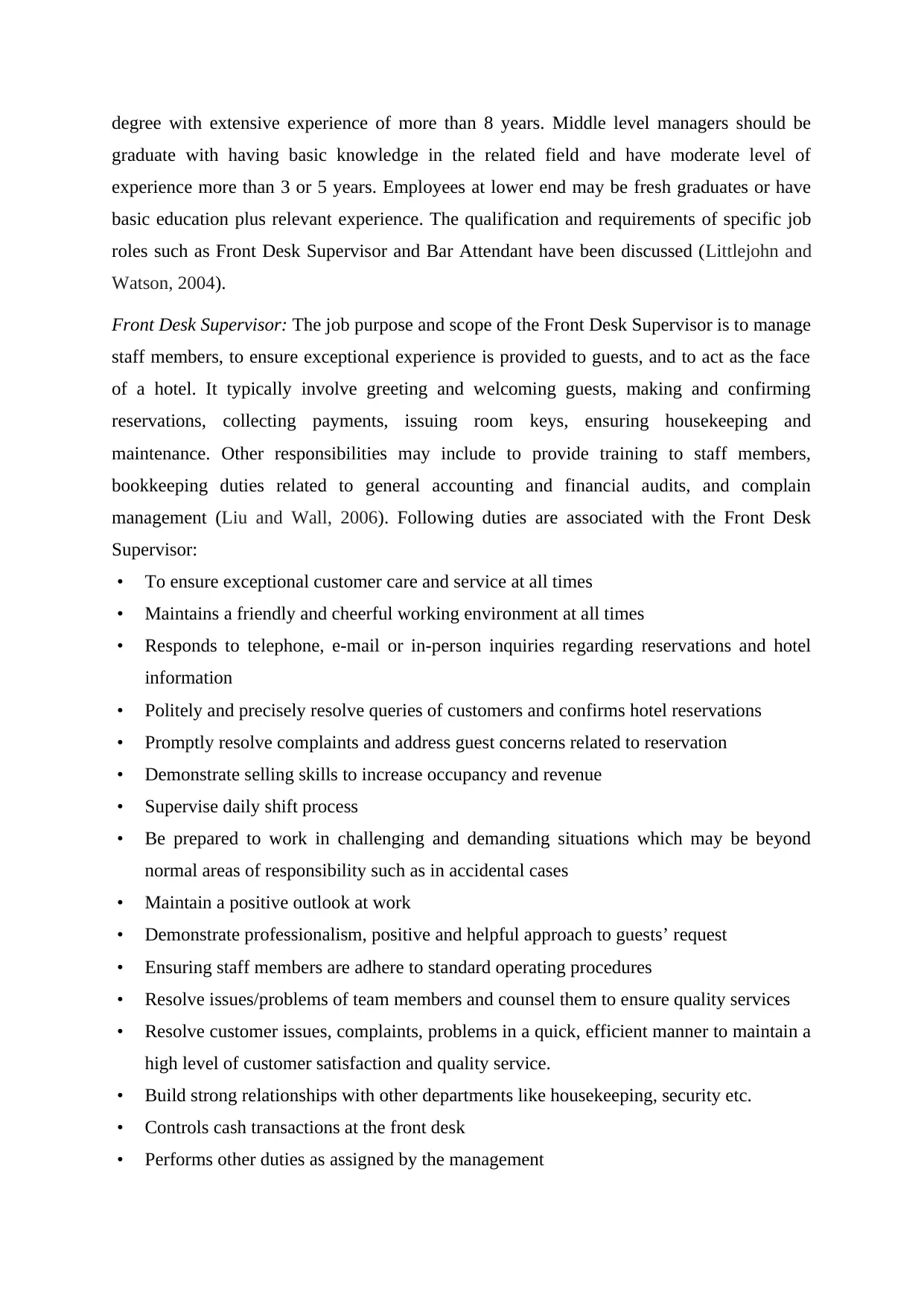
degree with extensive experience of more than 8 years. Middle level managers should be
graduate with having basic knowledge in the related field and have moderate level of
experience more than 3 or 5 years. Employees at lower end may be fresh graduates or have
basic education plus relevant experience. The qualification and requirements of specific job
roles such as Front Desk Supervisor and Bar Attendant have been discussed (Littlejohn and
Watson, 2004).
Front Desk Supervisor: The job purpose and scope of the Front Desk Supervisor is to manage
staff members, to ensure exceptional experience is provided to guests, and to act as the face
of a hotel. It typically involve greeting and welcoming guests, making and confirming
reservations, collecting payments, issuing room keys, ensuring housekeeping and
maintenance. Other responsibilities may include to provide training to staff members,
bookkeeping duties related to general accounting and financial audits, and complain
management (Liu and Wall, 2006). Following duties are associated with the Front Desk
Supervisor:
• To ensure exceptional customer care and service at all times
• Maintains a friendly and cheerful working environment at all times
• Responds to telephone, e-mail or in-person inquiries regarding reservations and hotel
information
• Politely and precisely resolve queries of customers and confirms hotel reservations
• Promptly resolve complaints and address guest concerns related to reservation
• Demonstrate selling skills to increase occupancy and revenue
• Supervise daily shift process
• Be prepared to work in challenging and demanding situations which may be beyond
normal areas of responsibility such as in accidental cases
• Maintain a positive outlook at work
• Demonstrate professionalism, positive and helpful approach to guests’ request
• Ensuring staff members are adhere to standard operating procedures
• Resolve issues/problems of team members and counsel them to ensure quality services
• Resolve customer issues, complaints, problems in a quick, efficient manner to maintain a
high level of customer satisfaction and quality service.
• Build strong relationships with other departments like housekeeping, security etc.
• Controls cash transactions at the front desk
• Performs other duties as assigned by the management
graduate with having basic knowledge in the related field and have moderate level of
experience more than 3 or 5 years. Employees at lower end may be fresh graduates or have
basic education plus relevant experience. The qualification and requirements of specific job
roles such as Front Desk Supervisor and Bar Attendant have been discussed (Littlejohn and
Watson, 2004).
Front Desk Supervisor: The job purpose and scope of the Front Desk Supervisor is to manage
staff members, to ensure exceptional experience is provided to guests, and to act as the face
of a hotel. It typically involve greeting and welcoming guests, making and confirming
reservations, collecting payments, issuing room keys, ensuring housekeeping and
maintenance. Other responsibilities may include to provide training to staff members,
bookkeeping duties related to general accounting and financial audits, and complain
management (Liu and Wall, 2006). Following duties are associated with the Front Desk
Supervisor:
• To ensure exceptional customer care and service at all times
• Maintains a friendly and cheerful working environment at all times
• Responds to telephone, e-mail or in-person inquiries regarding reservations and hotel
information
• Politely and precisely resolve queries of customers and confirms hotel reservations
• Promptly resolve complaints and address guest concerns related to reservation
• Demonstrate selling skills to increase occupancy and revenue
• Supervise daily shift process
• Be prepared to work in challenging and demanding situations which may be beyond
normal areas of responsibility such as in accidental cases
• Maintain a positive outlook at work
• Demonstrate professionalism, positive and helpful approach to guests’ request
• Ensuring staff members are adhere to standard operating procedures
• Resolve issues/problems of team members and counsel them to ensure quality services
• Resolve customer issues, complaints, problems in a quick, efficient manner to maintain a
high level of customer satisfaction and quality service.
• Build strong relationships with other departments like housekeeping, security etc.
• Controls cash transactions at the front desk
• Performs other duties as assigned by the management
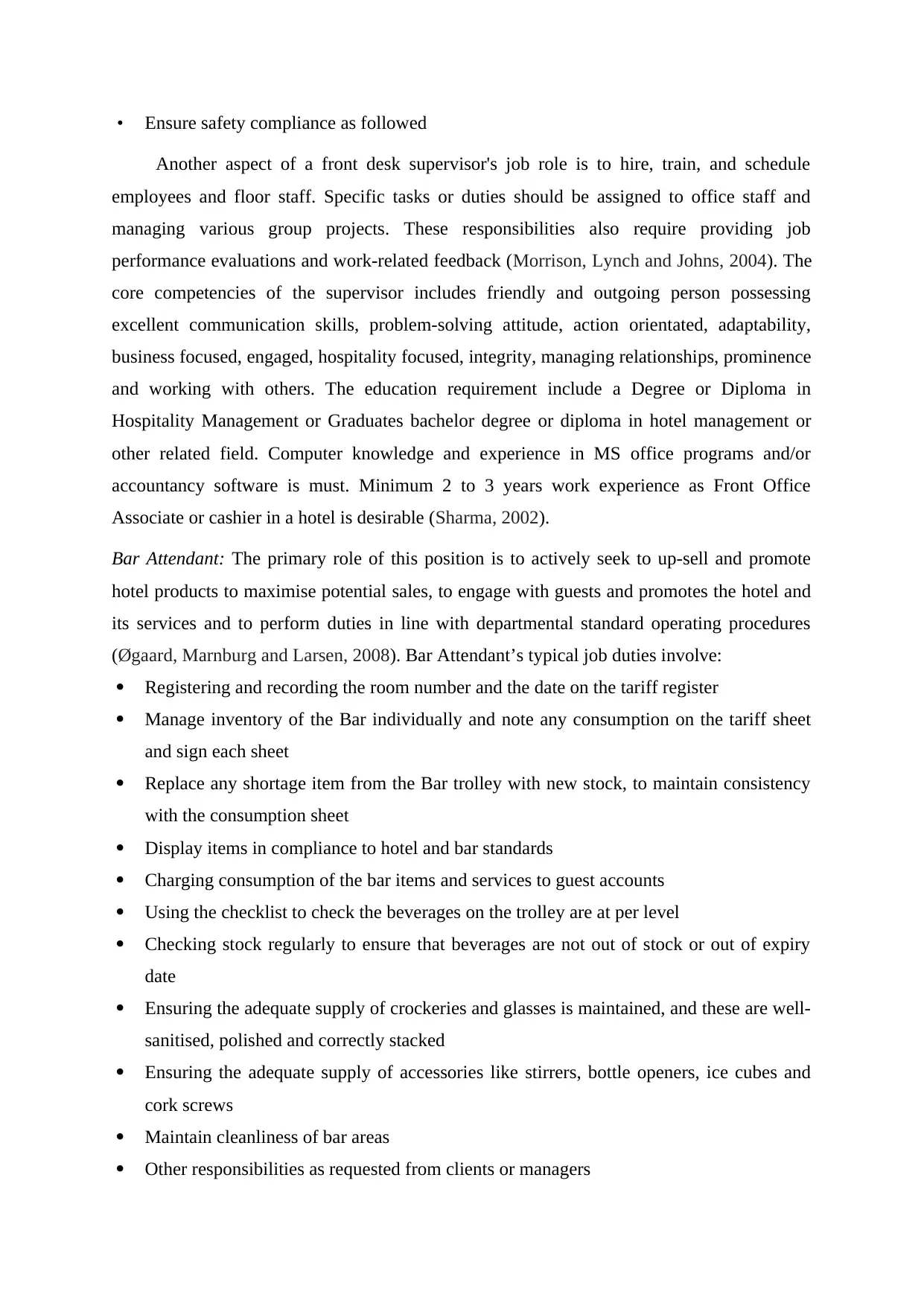
• Ensure safety compliance as followed
Another aspect of a front desk supervisor's job role is to hire, train, and schedule
employees and floor staff. Specific tasks or duties should be assigned to office staff and
managing various group projects. These responsibilities also require providing job
performance evaluations and work-related feedback (Morrison, Lynch and Johns, 2004). The
core competencies of the supervisor includes friendly and outgoing person possessing
excellent communication skills, problem-solving attitude, action orientated, adaptability,
business focused, engaged, hospitality focused, integrity, managing relationships, prominence
and working with others. The education requirement include a Degree or Diploma in
Hospitality Management or Graduates bachelor degree or diploma in hotel management or
other related field. Computer knowledge and experience in MS office programs and/or
accountancy software is must. Minimum 2 to 3 years work experience as Front Office
Associate or cashier in a hotel is desirable (Sharma, 2002).
Bar Attendant: The primary role of this position is to actively seek to up-sell and promote
hotel products to maximise potential sales, to engage with guests and promotes the hotel and
its services and to perform duties in line with departmental standard operating procedures
(Øgaard, Marnburg and Larsen, 2008). Bar Attendant’s typical job duties involve:
Registering and recording the room number and the date on the tariff register
Manage inventory of the Bar individually and note any consumption on the tariff sheet
and sign each sheet
Replace any shortage item from the Bar trolley with new stock, to maintain consistency
with the consumption sheet
Display items in compliance to hotel and bar standards
Charging consumption of the bar items and services to guest accounts
Using the checklist to check the beverages on the trolley are at per level
Checking stock regularly to ensure that beverages are not out of stock or out of expiry
date
Ensuring the adequate supply of crockeries and glasses is maintained, and these are well-
sanitised, polished and correctly stacked
Ensuring the adequate supply of accessories like stirrers, bottle openers, ice cubes and
cork screws
Maintain cleanliness of bar areas
Other responsibilities as requested from clients or managers
Another aspect of a front desk supervisor's job role is to hire, train, and schedule
employees and floor staff. Specific tasks or duties should be assigned to office staff and
managing various group projects. These responsibilities also require providing job
performance evaluations and work-related feedback (Morrison, Lynch and Johns, 2004). The
core competencies of the supervisor includes friendly and outgoing person possessing
excellent communication skills, problem-solving attitude, action orientated, adaptability,
business focused, engaged, hospitality focused, integrity, managing relationships, prominence
and working with others. The education requirement include a Degree or Diploma in
Hospitality Management or Graduates bachelor degree or diploma in hotel management or
other related field. Computer knowledge and experience in MS office programs and/or
accountancy software is must. Minimum 2 to 3 years work experience as Front Office
Associate or cashier in a hotel is desirable (Sharma, 2002).
Bar Attendant: The primary role of this position is to actively seek to up-sell and promote
hotel products to maximise potential sales, to engage with guests and promotes the hotel and
its services and to perform duties in line with departmental standard operating procedures
(Øgaard, Marnburg and Larsen, 2008). Bar Attendant’s typical job duties involve:
Registering and recording the room number and the date on the tariff register
Manage inventory of the Bar individually and note any consumption on the tariff sheet
and sign each sheet
Replace any shortage item from the Bar trolley with new stock, to maintain consistency
with the consumption sheet
Display items in compliance to hotel and bar standards
Charging consumption of the bar items and services to guest accounts
Using the checklist to check the beverages on the trolley are at per level
Checking stock regularly to ensure that beverages are not out of stock or out of expiry
date
Ensuring the adequate supply of crockeries and glasses is maintained, and these are well-
sanitised, polished and correctly stacked
Ensuring the adequate supply of accessories like stirrers, bottle openers, ice cubes and
cork screws
Maintain cleanliness of bar areas
Other responsibilities as requested from clients or managers
⊘ This is a preview!⊘
Do you want full access?
Subscribe today to unlock all pages.

Trusted by 1+ million students worldwide
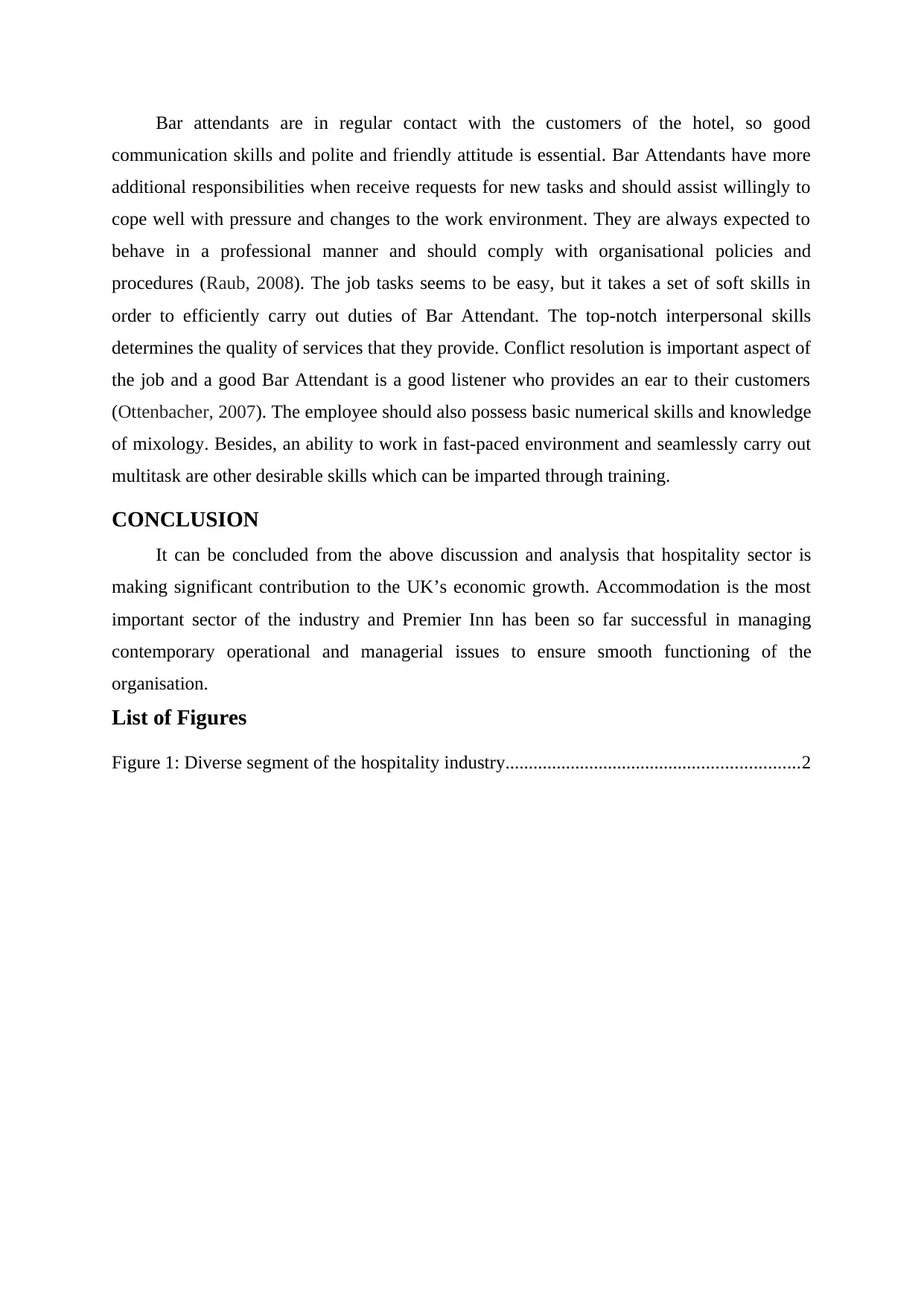
Bar attendants are in regular contact with the customers of the hotel, so good
communication skills and polite and friendly attitude is essential. Bar Attendants have more
additional responsibilities when receive requests for new tasks and should assist willingly to
cope well with pressure and changes to the work environment. They are always expected to
behave in a professional manner and should comply with organisational policies and
procedures (Raub, 2008). The job tasks seems to be easy, but it takes a set of soft skills in
order to efficiently carry out duties of Bar Attendant. The top-notch interpersonal skills
determines the quality of services that they provide. Conflict resolution is important aspect of
the job and a good Bar Attendant is a good listener who provides an ear to their customers
(Ottenbacher, 2007). The employee should also possess basic numerical skills and knowledge
of mixology. Besides, an ability to work in fast-paced environment and seamlessly carry out
multitask are other desirable skills which can be imparted through training.
CONCLUSION
It can be concluded from the above discussion and analysis that hospitality sector is
making significant contribution to the UK’s economic growth. Accommodation is the most
important sector of the industry and Premier Inn has been so far successful in managing
contemporary operational and managerial issues to ensure smooth functioning of the
organisation.
List of Figures
Figure 1: Diverse segment of the hospitality industry...............................................................2
communication skills and polite and friendly attitude is essential. Bar Attendants have more
additional responsibilities when receive requests for new tasks and should assist willingly to
cope well with pressure and changes to the work environment. They are always expected to
behave in a professional manner and should comply with organisational policies and
procedures (Raub, 2008). The job tasks seems to be easy, but it takes a set of soft skills in
order to efficiently carry out duties of Bar Attendant. The top-notch interpersonal skills
determines the quality of services that they provide. Conflict resolution is important aspect of
the job and a good Bar Attendant is a good listener who provides an ear to their customers
(Ottenbacher, 2007). The employee should also possess basic numerical skills and knowledge
of mixology. Besides, an ability to work in fast-paced environment and seamlessly carry out
multitask are other desirable skills which can be imparted through training.
CONCLUSION
It can be concluded from the above discussion and analysis that hospitality sector is
making significant contribution to the UK’s economic growth. Accommodation is the most
important sector of the industry and Premier Inn has been so far successful in managing
contemporary operational and managerial issues to ensure smooth functioning of the
organisation.
List of Figures
Figure 1: Diverse segment of the hospitality industry...............................................................2
Paraphrase This Document
Need a fresh take? Get an instant paraphrase of this document with our AI Paraphraser
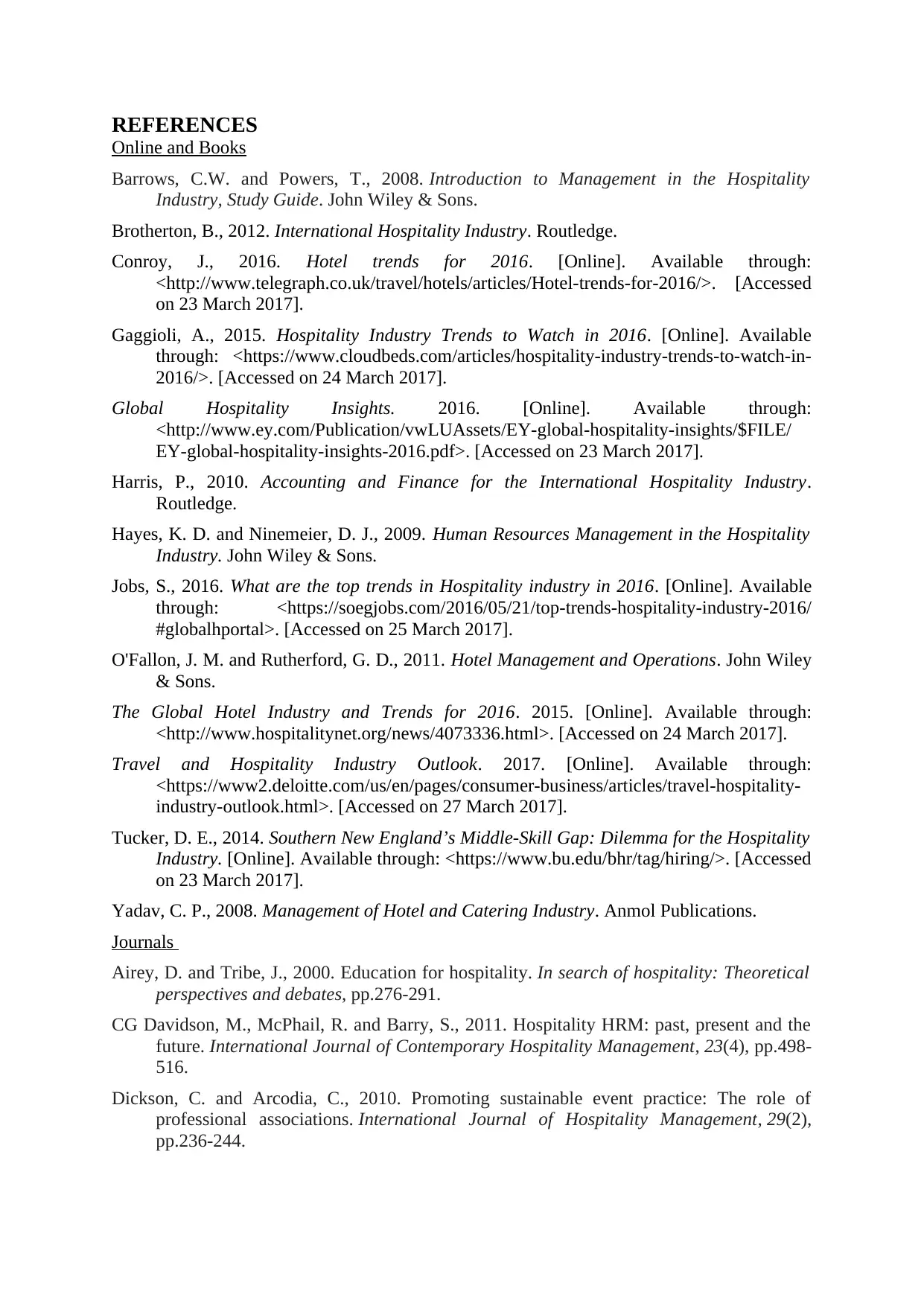
REFERENCES
Online and Books
Barrows, C.W. and Powers, T., 2008. Introduction to Management in the Hospitality
Industry, Study Guide. John Wiley & Sons.
Brotherton, B., 2012. International Hospitality Industry. Routledge.
Conroy, J., 2016. Hotel trends for 2016. [Online]. Available through:
<http://www.telegraph.co.uk/travel/hotels/articles/Hotel-trends-for-2016/>. [Accessed
on 23 March 2017].
Gaggioli, A., 2015. Hospitality Industry Trends to Watch in 2016. [Online]. Available
through: <https://www.cloudbeds.com/articles/hospitality-industry-trends-to-watch-in-
2016/>. [Accessed on 24 March 2017].
Global Hospitality Insights. 2016. [Online]. Available through:
<http://www.ey.com/Publication/vwLUAssets/EY-global-hospitality-insights/$FILE/
EY-global-hospitality-insights-2016.pdf>. [Accessed on 23 March 2017].
Harris, P., 2010. Accounting and Finance for the International Hospitality Industry.
Routledge.
Hayes, K. D. and Ninemeier, D. J., 2009. Human Resources Management in the Hospitality
Industry. John Wiley & Sons.
Jobs, S., 2016. What are the top trends in Hospitality industry in 2016. [Online]. Available
through: <https://soegjobs.com/2016/05/21/top-trends-hospitality-industry-2016/
#globalhportal>. [Accessed on 25 March 2017].
O'Fallon, J. M. and Rutherford, G. D., 2011. Hotel Management and Operations. John Wiley
& Sons.
The Global Hotel Industry and Trends for 2016. 2015. [Online]. Available through:
<http://www.hospitalitynet.org/news/4073336.html>. [Accessed on 24 March 2017].
Travel and Hospitality Industry Outlook. 2017. [Online]. Available through:
<https://www2.deloitte.com/us/en/pages/consumer-business/articles/travel-hospitality-
industry-outlook.html>. [Accessed on 27 March 2017].
Tucker, D. E., 2014. Southern New England’s Middle-Skill Gap: Dilemma for the Hospitality
Industry. [Online]. Available through: <https://www.bu.edu/bhr/tag/hiring/>. [Accessed
on 23 March 2017].
Yadav, C. P., 2008. Management of Hotel and Catering Industry. Anmol Publications.
Journals
Airey, D. and Tribe, J., 2000. Education for hospitality. In search of hospitality: Theoretical
perspectives and debates, pp.276-291.
CG Davidson, M., McPhail, R. and Barry, S., 2011. Hospitality HRM: past, present and the
future. International Journal of Contemporary Hospitality Management, 23(4), pp.498-
516.
Dickson, C. and Arcodia, C., 2010. Promoting sustainable event practice: The role of
professional associations. International Journal of Hospitality Management, 29(2),
pp.236-244.
Online and Books
Barrows, C.W. and Powers, T., 2008. Introduction to Management in the Hospitality
Industry, Study Guide. John Wiley & Sons.
Brotherton, B., 2012. International Hospitality Industry. Routledge.
Conroy, J., 2016. Hotel trends for 2016. [Online]. Available through:
<http://www.telegraph.co.uk/travel/hotels/articles/Hotel-trends-for-2016/>. [Accessed
on 23 March 2017].
Gaggioli, A., 2015. Hospitality Industry Trends to Watch in 2016. [Online]. Available
through: <https://www.cloudbeds.com/articles/hospitality-industry-trends-to-watch-in-
2016/>. [Accessed on 24 March 2017].
Global Hospitality Insights. 2016. [Online]. Available through:
<http://www.ey.com/Publication/vwLUAssets/EY-global-hospitality-insights/$FILE/
EY-global-hospitality-insights-2016.pdf>. [Accessed on 23 March 2017].
Harris, P., 2010. Accounting and Finance for the International Hospitality Industry.
Routledge.
Hayes, K. D. and Ninemeier, D. J., 2009. Human Resources Management in the Hospitality
Industry. John Wiley & Sons.
Jobs, S., 2016. What are the top trends in Hospitality industry in 2016. [Online]. Available
through: <https://soegjobs.com/2016/05/21/top-trends-hospitality-industry-2016/
#globalhportal>. [Accessed on 25 March 2017].
O'Fallon, J. M. and Rutherford, G. D., 2011. Hotel Management and Operations. John Wiley
& Sons.
The Global Hotel Industry and Trends for 2016. 2015. [Online]. Available through:
<http://www.hospitalitynet.org/news/4073336.html>. [Accessed on 24 March 2017].
Travel and Hospitality Industry Outlook. 2017. [Online]. Available through:
<https://www2.deloitte.com/us/en/pages/consumer-business/articles/travel-hospitality-
industry-outlook.html>. [Accessed on 27 March 2017].
Tucker, D. E., 2014. Southern New England’s Middle-Skill Gap: Dilemma for the Hospitality
Industry. [Online]. Available through: <https://www.bu.edu/bhr/tag/hiring/>. [Accessed
on 23 March 2017].
Yadav, C. P., 2008. Management of Hotel and Catering Industry. Anmol Publications.
Journals
Airey, D. and Tribe, J., 2000. Education for hospitality. In search of hospitality: Theoretical
perspectives and debates, pp.276-291.
CG Davidson, M., McPhail, R. and Barry, S., 2011. Hospitality HRM: past, present and the
future. International Journal of Contemporary Hospitality Management, 23(4), pp.498-
516.
Dickson, C. and Arcodia, C., 2010. Promoting sustainable event practice: The role of
professional associations. International Journal of Hospitality Management, 29(2),
pp.236-244.
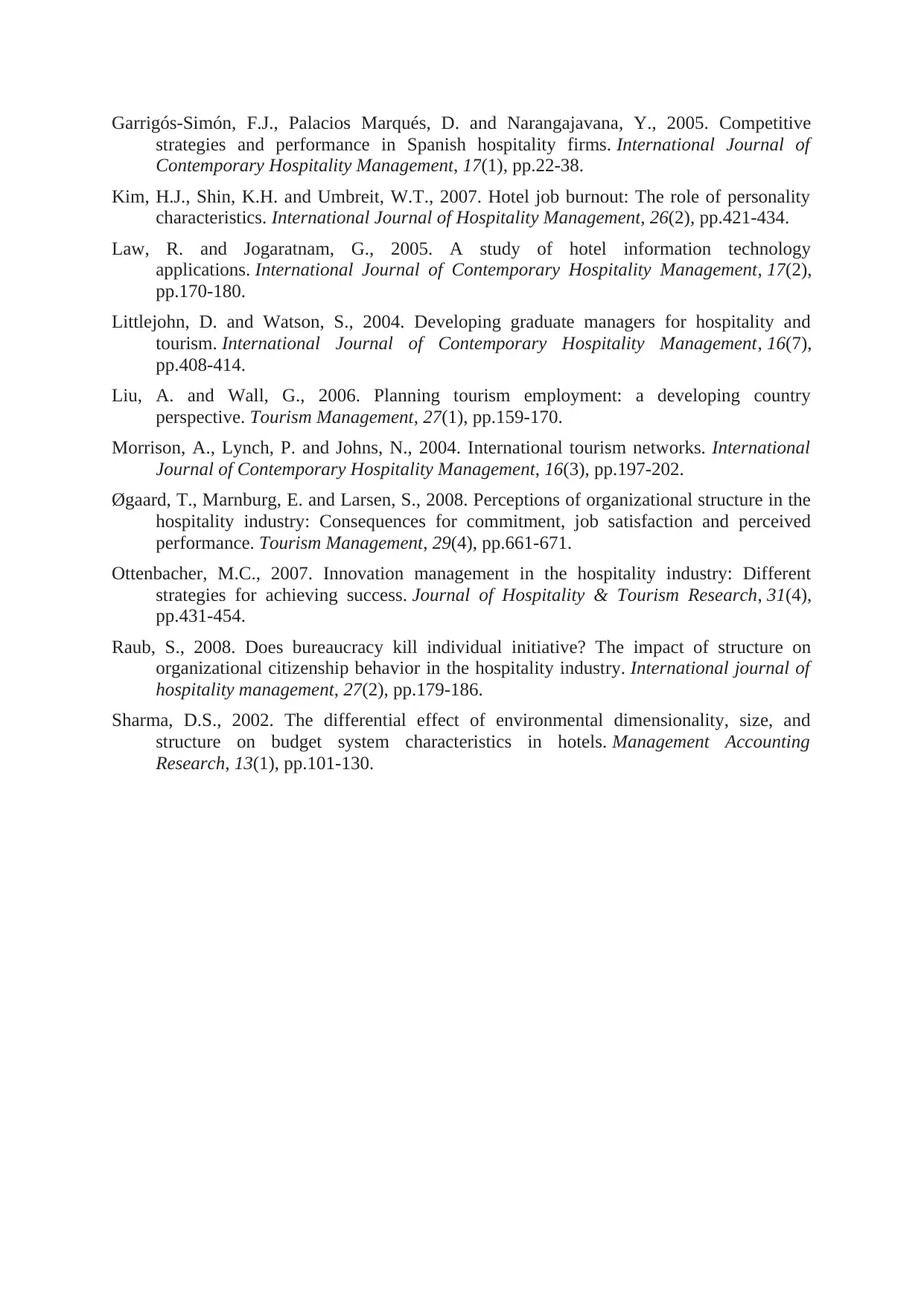
Garrigós-Simón, F.J., Palacios Marqués, D. and Narangajavana, Y., 2005. Competitive
strategies and performance in Spanish hospitality firms. International Journal of
Contemporary Hospitality Management, 17(1), pp.22-38.
Kim, H.J., Shin, K.H. and Umbreit, W.T., 2007. Hotel job burnout: The role of personality
characteristics. International Journal of Hospitality Management, 26(2), pp.421-434.
Law, R. and Jogaratnam, G., 2005. A study of hotel information technology
applications. International Journal of Contemporary Hospitality Management, 17(2),
pp.170-180.
Littlejohn, D. and Watson, S., 2004. Developing graduate managers for hospitality and
tourism. International Journal of Contemporary Hospitality Management, 16(7),
pp.408-414.
Liu, A. and Wall, G., 2006. Planning tourism employment: a developing country
perspective. Tourism Management, 27(1), pp.159-170.
Morrison, A., Lynch, P. and Johns, N., 2004. International tourism networks. International
Journal of Contemporary Hospitality Management, 16(3), pp.197-202.
Øgaard, T., Marnburg, E. and Larsen, S., 2008. Perceptions of organizational structure in the
hospitality industry: Consequences for commitment, job satisfaction and perceived
performance. Tourism Management, 29(4), pp.661-671.
Ottenbacher, M.C., 2007. Innovation management in the hospitality industry: Different
strategies for achieving success. Journal of Hospitality & Tourism Research, 31(4),
pp.431-454.
Raub, S., 2008. Does bureaucracy kill individual initiative? The impact of structure on
organizational citizenship behavior in the hospitality industry. International journal of
hospitality management, 27(2), pp.179-186.
Sharma, D.S., 2002. The differential effect of environmental dimensionality, size, and
structure on budget system characteristics in hotels. Management Accounting
Research, 13(1), pp.101-130.
strategies and performance in Spanish hospitality firms. International Journal of
Contemporary Hospitality Management, 17(1), pp.22-38.
Kim, H.J., Shin, K.H. and Umbreit, W.T., 2007. Hotel job burnout: The role of personality
characteristics. International Journal of Hospitality Management, 26(2), pp.421-434.
Law, R. and Jogaratnam, G., 2005. A study of hotel information technology
applications. International Journal of Contemporary Hospitality Management, 17(2),
pp.170-180.
Littlejohn, D. and Watson, S., 2004. Developing graduate managers for hospitality and
tourism. International Journal of Contemporary Hospitality Management, 16(7),
pp.408-414.
Liu, A. and Wall, G., 2006. Planning tourism employment: a developing country
perspective. Tourism Management, 27(1), pp.159-170.
Morrison, A., Lynch, P. and Johns, N., 2004. International tourism networks. International
Journal of Contemporary Hospitality Management, 16(3), pp.197-202.
Øgaard, T., Marnburg, E. and Larsen, S., 2008. Perceptions of organizational structure in the
hospitality industry: Consequences for commitment, job satisfaction and perceived
performance. Tourism Management, 29(4), pp.661-671.
Ottenbacher, M.C., 2007. Innovation management in the hospitality industry: Different
strategies for achieving success. Journal of Hospitality & Tourism Research, 31(4),
pp.431-454.
Raub, S., 2008. Does bureaucracy kill individual initiative? The impact of structure on
organizational citizenship behavior in the hospitality industry. International journal of
hospitality management, 27(2), pp.179-186.
Sharma, D.S., 2002. The differential effect of environmental dimensionality, size, and
structure on budget system characteristics in hotels. Management Accounting
Research, 13(1), pp.101-130.
⊘ This is a preview!⊘
Do you want full access?
Subscribe today to unlock all pages.

Trusted by 1+ million students worldwide
1 out of 12
Related Documents
Your All-in-One AI-Powered Toolkit for Academic Success.
+13062052269
info@desklib.com
Available 24*7 on WhatsApp / Email
![[object Object]](/_next/static/media/star-bottom.7253800d.svg)
Unlock your academic potential
Copyright © 2020–2025 A2Z Services. All Rights Reserved. Developed and managed by ZUCOL.





